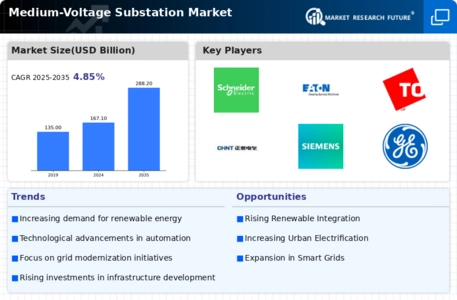Urbanization and Industrial Growth
Urbanization and industrial growth are key factors propelling the Medium-Voltage Substation Market. As populations migrate to urban areas, the demand for electricity surges, necessitating the expansion of electrical infrastructure. This urban expansion is often accompanied by increased industrial activities, which further amplify the need for reliable power distribution systems. Data suggests that urban areas are projected to account for over 70% of global electricity consumption by 2030, highlighting the critical role of medium-voltage substations in meeting this demand. Consequently, utilities and developers are likely to invest heavily in medium-voltage substations to ensure that the growing energy needs of urban centers and industries are met efficiently.
Increasing Demand for Reliable Power Supply
The Medium-Voltage Substation Market is experiencing a surge in demand for reliable power supply solutions. As urbanization accelerates and industrial activities expand, the need for stable electricity distribution becomes paramount. This trend is particularly evident in developing regions, where infrastructure development is underway. According to recent data, the demand for medium-voltage substations is projected to grow at a compound annual growth rate of approximately 6% over the next five years. This growth is driven by the necessity to enhance grid reliability and reduce outages, which are critical for both residential and commercial sectors. Consequently, investments in medium-voltage substations are likely to increase, as utilities and private enterprises seek to modernize their electrical infrastructure.
Rising Investment in Renewable Energy Projects
The Medium-Voltage Substation Market is significantly influenced by the rising investment in renewable energy projects. As countries strive to meet their energy transition goals, there is a marked increase in the deployment of solar, wind, and other renewable energy sources. This shift necessitates the establishment of robust medium-voltage substations to manage the distribution of generated power effectively. Recent statistics indicate that investments in renewable energy infrastructure are expected to exceed several billion dollars annually, creating a substantial demand for medium-voltage substations. This trend not only supports the growth of the market but also aligns with global sustainability objectives, making it a pivotal driver for future developments.
Technological Innovations in Substation Design
Technological advancements are reshaping the Medium-Voltage Substation Market, with innovations in design and operation enhancing efficiency and reliability. The introduction of smart grid technologies, automation, and digital monitoring systems is revolutionizing how substations function. These innovations not only improve operational efficiency but also facilitate better integration of renewable energy sources. For example, the deployment of advanced sensors and data analytics allows for real-time monitoring and predictive maintenance, reducing downtime and operational costs. As these technologies become more prevalent, the market for medium-voltage substations is likely to witness a significant transformation, with an estimated growth rate of 7% in the coming years.
Regulatory Support for Infrastructure Development
The Medium-Voltage Substation Market benefits from favorable regulatory frameworks that promote infrastructure development. Governments are increasingly recognizing the importance of robust electrical networks to support economic growth and energy security. Policies aimed at enhancing grid resilience and integrating renewable energy sources are being implemented, which in turn drives the demand for medium-voltage substations. For instance, various countries have set ambitious targets for renewable energy adoption, necessitating the upgrade of existing substations to accommodate new technologies. This regulatory support is expected to catalyze investments in the medium-voltage substation sector, potentially leading to a market expansion of around 5% annually over the next few years.

















Leave a Comment